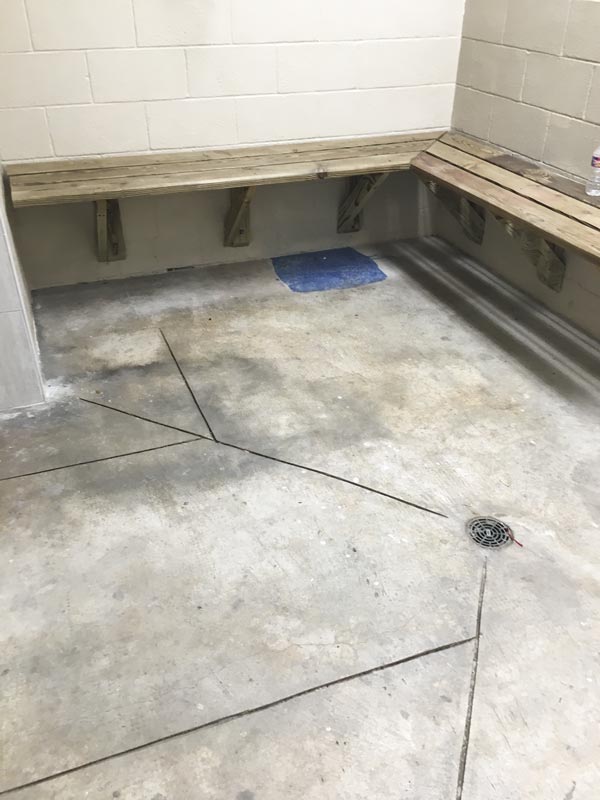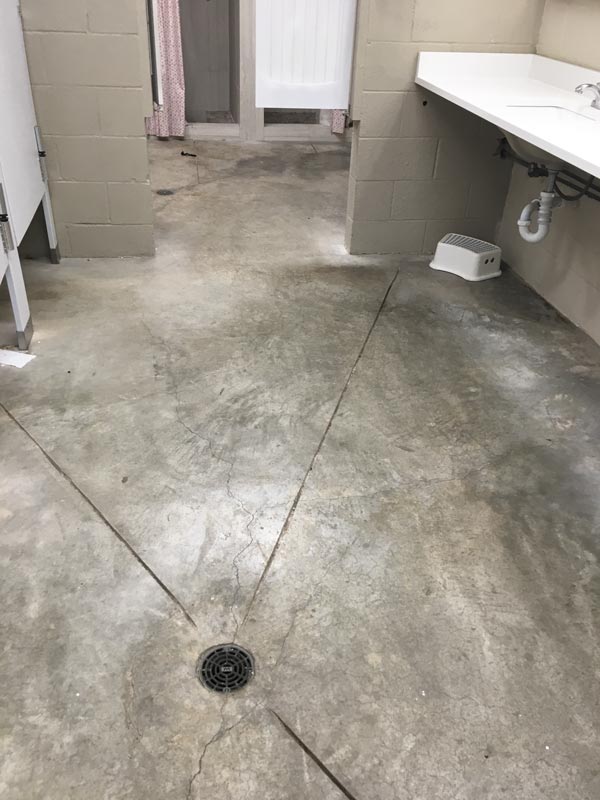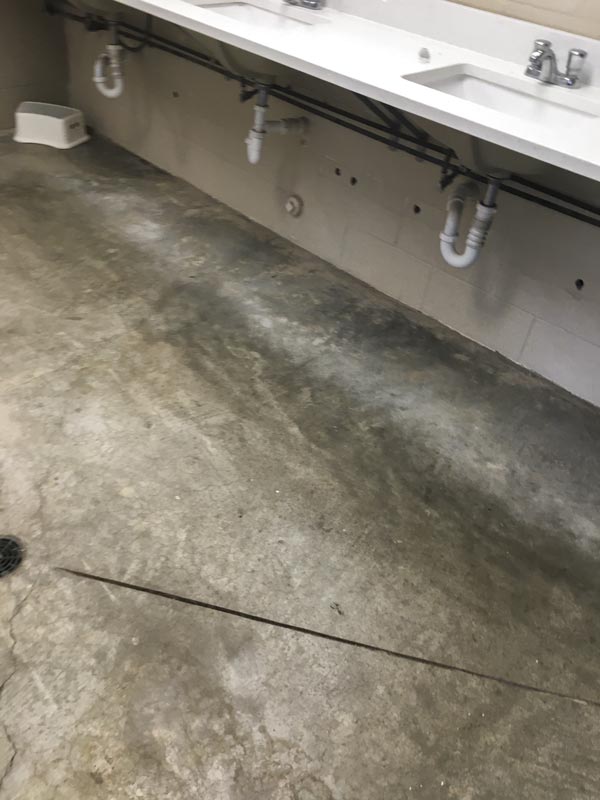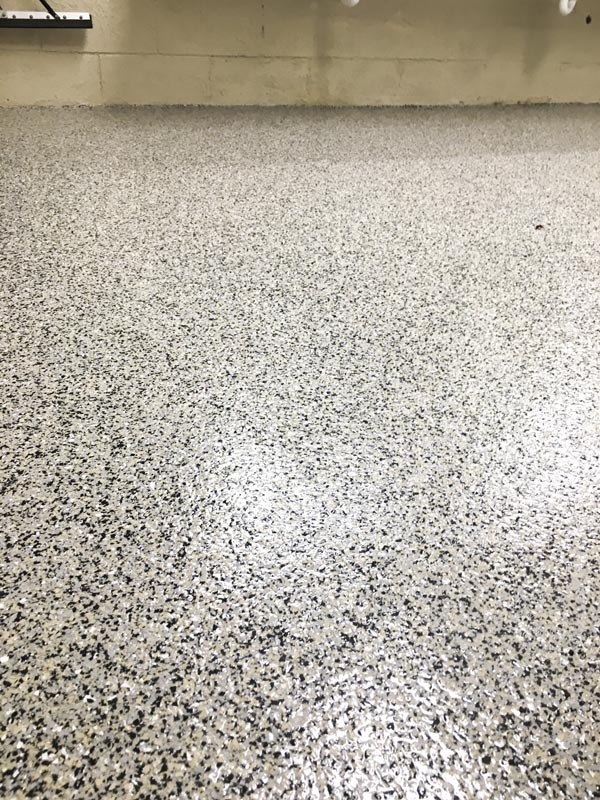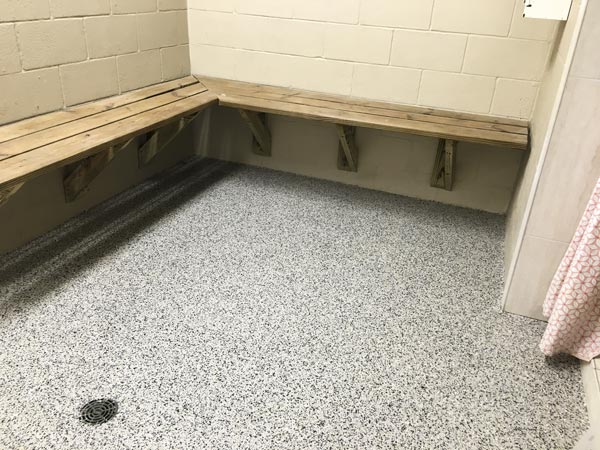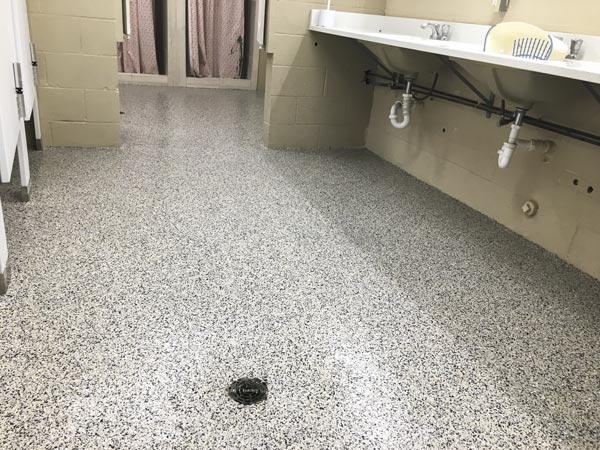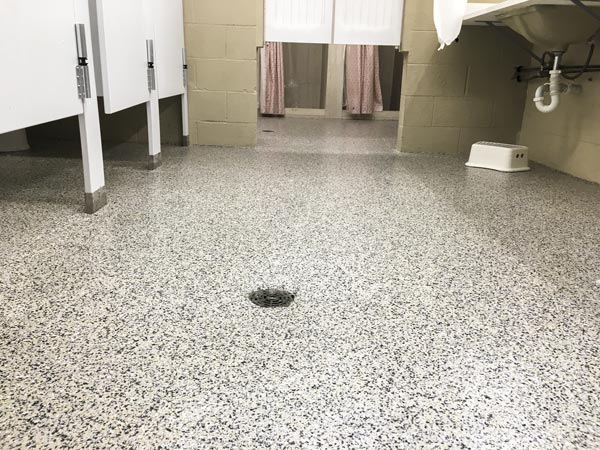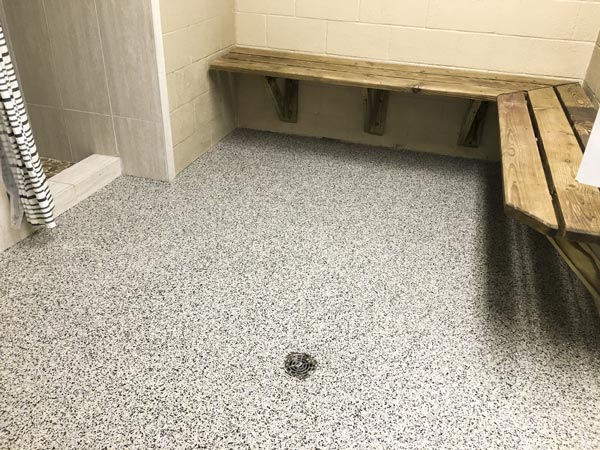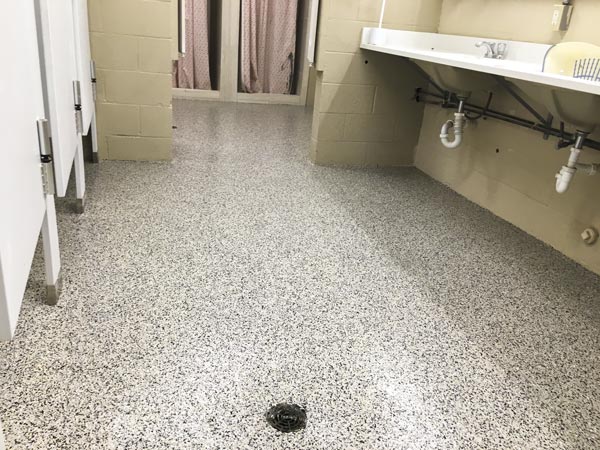The Garage Makeover Blog by Slide-Lok
Polyaspartic Floor Coating Withstands Lake Travis Flooding - Austin, TX
4/25/2019

Austin Yacht Club underwater at Lake Travis. Water level of 704.23' at 3 p.m. 10/19/18. Photo courtesy of Kurt Carson.
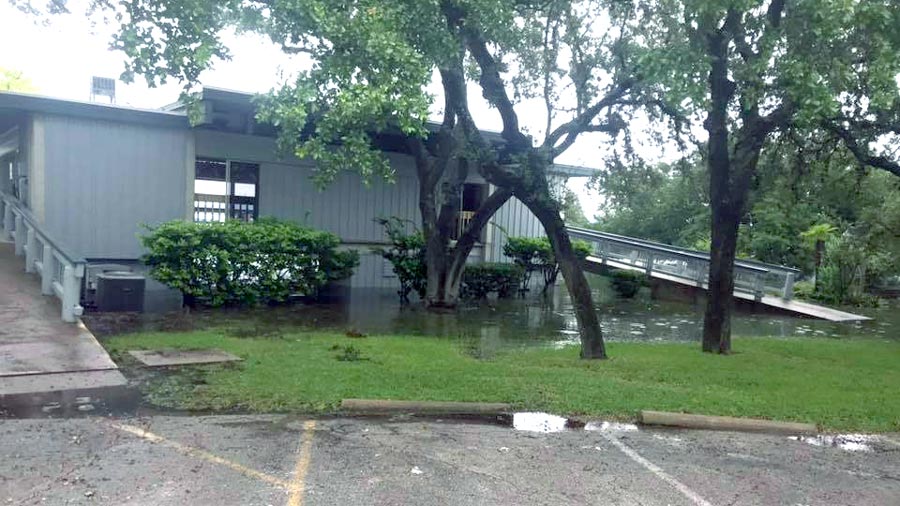
The lower level of the Austin Yacht Club was underwater on October 19, 2018. Photo courtesy of Elizabeth Quintanilla.
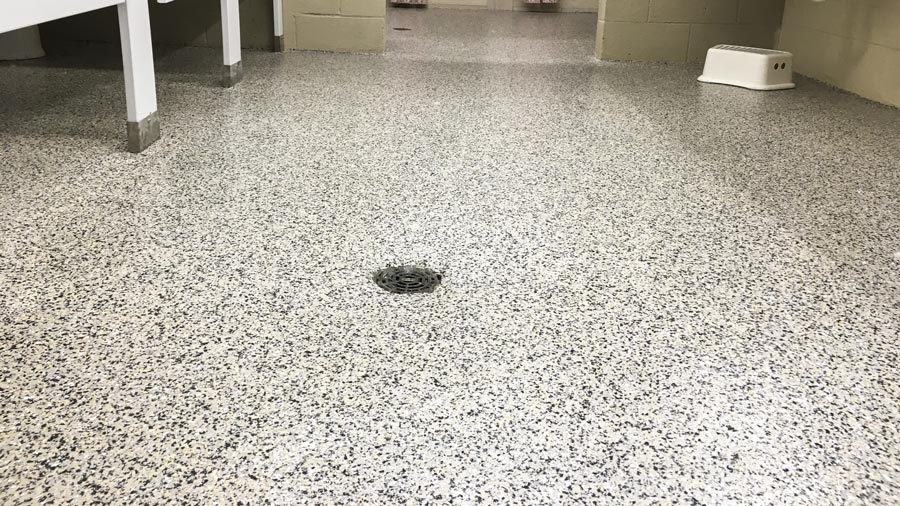
"When it was all washed and cleaned the floor looks like new." - GM, Austin Yacht Club
Austin Yacht Club Bathroom Floor Install - May, 2018
Last summer, our local floor coating installer, Monty Patton, was contracted to install a new polyaspartic floor coating in the bathroom facilities of the Austin Yacht Club in Austin, Texas. The requirements for the yacht club bathroom floor stated that it needed to be easy to clean, impervious to water, dirt, mud, mild soap/shampoo, and look good. With those requirements in mind, Monty knew that a resinous polyaspartic floor coating would be perfect for this job. The floor was completed in May of 2018. The GM was pleased with the floor - another happy customer!
"Ooooohhh I like it!"GM, Austin Yacht Club at Lake Travis
~ 6 months later ...
Lake Travis Flooding Threatens Communities
On October 16, 2018, the Highland Lakes in Central Texas received significant rainfall resulting in massive flooding along the chain of lakes. The surrounding areas received 8-12 inches of rain that Sunday through Tuesday, 6 inches of which came early Tuesday morning. Lake Travis is the second to last lake in the chain, closest to Austin, Texas. Lake Travis' all time highest water level was 710.44' on December 25, 1991. On October 20, 2018, Lake Travis reached 704.39', 23' over capacity, marking the 5th highest water level for the lake, and the highest water level in the last 26 years.
- Lake Travis Flood Victims Face The Damage Left Behind
- Lake Travis Swells, Floods Graveyard Point Neighborhood
All events at Austin Yacht Club this weekend (Oct 20-21) are cancelled due to flooding. * Kathryn Hammond Memorial...
Posted by Austin Yacht Club on Wednesday, October 17, 2018
Polyaspartic Floor Coating Held Up After The Flood
Flooding devastated communities around Lake Travis for several weeks following October 17, 2018. In January of 2019, our flooring contractor finally heard from the GM of the Austin Yacht Club. To their surprise our polyaspartic floor held up during and after "the flood". They stated they could not believe it since their facilities were under water for several weeks and covered in all kinds of mud and grime. They washed and cleaned the floors and were surprised they came back to looking brand new. Polyaspartic flooring withstands flooding, quite the testament to our flooring chemistry.
"Monty, I have to tell you that your floors held up well during 'the flood' on Lake Travis last October. I couldn’t believe it, but they were under water for at least 2 weeks with slime, seaweed and nasty water. When it was all washed and cleaned the floor looks like new. That is an amazing testament to your flooring." GM, Austin Yacht Club at Lake Travis
Polyaspartic Polyurea Chemistry Is Extremely Durable
Polyaspartic polyurea coatings are extremely durable technologies and offer many advantages over traditional lower cost, lower performance, self crosslinking acrylics and alkyd paints of yesterday. The inherent strength of polyaspartic technology comes from its aliphatic backbone and high crosslinking density that allows it to be strong and resistant for many applications. These coatings were originally released as environmental control / protection coatings for architectural and structural devices. Think bridges, water tanks, rail cars, pipes, oil platforms/rigs, etc... Pretty much any metal or concrete surface exposed to salt, water and UV conditions; such conditions are known to deteriorate substrates and coatings over time. Along the coast salt fog spray and UV exposure can cause steel to rust, polyaspartic and other polyurethane 2k type coatings offer excellent corrosion protection specifically for these environments. Eventually, this technology was adapted for flooring and automotive top coats because of its superior traits featuring excellent durability, corrosion resistance, and quick application/return to service times.
However, this floor was submerged in water, why aren't we concerned about moisture vapor transmission (MVT) delaminating the coating? MVT can certainly present itself as an aqueous layer and pressure that can interfere between substrate and coating layer. In moisture related flooring failures the weakest link in the architectural system will fail first, which is usually the coating. Fortunately for the Austin Yacht Club we don't take shortcuts on our flooring preparation methods. In this case the substrate, concrete, was diamond grinded. This allows the polyaspartic to soak into the concrete and to fill gaps in the pores locking itself to the concrete. It would take a lot of MVT over a significant period of time to delaminate the coating.
In this situation the floor survived because it was installed correctly six months prior. The polyaspartic polyurea coating fully cured months ago and is basically a 100% solid plastic layer bonded to the floor, technically a thermoset plastic or highly crosslinked polymer resin (involving a catalyst and exothermic reaction). When substrate prep and primer are applied correctly this floor coating can tolerate moderate MVT for short periods of time. A short period of time for example would be during/after a rainstorm when the surrounding soil is wet, but returns to normal within a few days. The Austin Yacht Club can thank physics and luck for saving their floor. When water / moisture vapor pressure manifests itself beneath a floor for extended periods of time it can cause coating delamination, peel, popping and bubbling. However, when moisture is beneath and above the floor like when the flood submerged the floor, the water pressure forces were equalized. After the area drained and the concrete returned to normal moisture levels the floor remained intact because any possible MVT did not remain for extended periods of time. It's currently April 25th as I'm writing this, if the MVT remained elevated since October of 2018, we would have seen problems by now. Moisture laden flooring problems typically manifest themselves within 4-6 weeks after installation or a moisture related problem such as flooding or a pipe burst.
Sources of Excess Moisture in Concrete
- Standing/free water
- Too much water in concrete mix
- Moisture rising from beneath the slab
- Poor ventilation
- Groundwater and poor drainage
- Leaks
- Inadequate landscaping grade
- Lack of protection from the elements
- Lack of climate control
- Dew point condensation
- High relative humidity levels
- Not allowing concrete to dry and cure properly
- Failing to install a vapor barrier
All of these points are important to keep in mind when hiring a concrete contractor, since moisture can seriously impact the strength of concrete. Too much excess water in cement results in lower concrete pore density, which results in less dense concrete. Less dense concrete is weaker concrete, it has significantly reduced compressive strength and durability. This occurs because as the concrete cures, the water slowly evaporates and leaves air behind in its place. For instance, concrete with 10% trapped air density can result in compressive strength reductions of as much as 40%!
Now lets look at the last four bold points as they are extremely important in applying decorative concrete coatings. Applying the wrong coating at the wrong time can negatively impact the performance and appeal of your floor. Solvent based coatings and 100% solvent reducible coatings are extremely vulnerable in these situations and can result in coating failure. Excess moisture negatively affects the rate of cure, adhesion, appearance, and physical strength/chemical resistant properties.
Some concrete slabs will have abnormally high moisture levels for life simply because of where they are located. Think of concrete slabs located in environments with rain year round, where their water table level is closer to the surface. These high moisture environments can present a challenge for all types of concrete workers. For pourers it can significantly affect the cure time and strength of the concrete. For decorative concrete applicators the moisture can significantly impact their ability to get a coating to adhere to the floor. Knowing how to address these issues is what sets the pros apart from the rest.
Vapor Barriers & Moisture Mitigation Coating Systems
The solution to moisture laden concrete slabs could be a moisture mitigation coating system, these are also called vapor barriers. Vapor barrier coatings are useful when other means of moisture mitigation were not taken or have failed. Traditional vapor barriers or vapor retarders included plastic tarping/sheets (polyethylene plastic) laid beneath concrete pours to prevent water vapor from penetrating the slab. Water vapors penetrating concrete slabs can cause issues such as cold, damp, clammy feeling concrete that never goes away, delaminating coatings/sealers, discoloring acid stains, producing efflorescence on the surface, damaging aggregates, and even causing the concrete slab to crack, bend or curl and move beneath objects in the floor.
Thanks to new coating technology you don't have to forgo decorative concrete coatings or live with cold, damp, clammy concrete any longer. New concrete coating vapor barriers are high solids, extremely low viscosity coatings. Our new Epoxy 150 W coating is a high solids, extremely low viscosity, low VOC coating. It features specialty wetting additives and siloxane technology to ensure excellent adhesion to properly prepared concrete. Our specialty epoxy formulation was designed specifically for use in moisture laden concrete slabs. This means it can be applied to green concrete (freshly poured concrete) in addition to older concrete that happens to be moisture laden. This epoxy primer vapor barrier features excellent adhesion, reduction or elimination of gassing bubbles in concrete, and sealing water penetration. The key to its success is its extremely low viscosity and additive combination that allows it to wet into concrete, it fills empty pores densifying the concrete surface creating an ultra strong surface bond. This vapor barrier is capable of withstanding 6-12 lbs of MVT depending on solids percentage and number of coats applied. For more information on this vapor barrier please contact us.
Before and After photos of the Austin Yacht Club bathroom floor from May 2018.
Become a Slide-Lok Floor & Cabinet Dealer
Open your contracting business to more opportunities with Slide-Lok. Slide-Lok is your one stop shop for garage flooring and storage solutions since 1977. Inquire today and discover the benefits of Slide-Lok Garage Interiors.
About The Author

Samuel Strayer is a trained chemist with a Bachelor of Science in Biochemistry from Arizona State University with an emphasis on material and polymer science. Samuel has been involved in developing and testing coating systems for over 10 years.
Keywords: Austin, TX, Texas, Polyaspartic, Floor, Flooring, Coating, Flood, Lake Travis, Flood, Flooding, Yacht, Club, Impervious, Durable, Polymer, Coatings, 78734
© Copyright, 2019, Slide-Lok (DBA), Mirabel Coatings Inc.
Back to Posts on The Garage Makeover Blog
Contact Local Dealer
Find a Slide-Lok Garage Floor & Cabinet dealer in your area.
Call: 1-800-835-1759
E-mail: Click to e-mail.
Featured Blog Posts
- Concrete Coating System Adhesion Study
- We Want To Thank Our Suppliers!
- Closed July 2-5 for Independence Day
- Best Garage Floor Coatings in Phoenix, AZ
- New Flooring Chips and Flakes Brochure - Featuring 41 Colors!
- How To Choose The Right Color To Paint Your Garage
- 41 Stock Blends of Color Chips and Flakes for Floor Coatings
- 6 New Color Chips & Flakes for Floor Coatings
- Residential and Commercial Floor Coatings in Phoenix, Arizona
- 13 New Color Chips & Flakes for Floor Coatings
- 4 Home Improvement and Organizational Tips To Elevate Your Home
- Floor Coating Video
- Failed DIY Garage Floor Coating vs. Pro
- How To Get Smoother Top Coats, Chip and Flake Floor Coating Sealer
- Closed Labor Day Weekend Sept. 4-7
- Garage Floor Coating Transformation in Laramie, Wyoming
- Flooring Chips and Flakes Now Available By The Bucket
- Closed July 3-6 For Independence Day
- Fighting Allergies During COVID-19
- Become An Authorized Slide-Lok Floor Coating and Storage Installer
- Inventory Levels and Lead Times - Impacted Supply Chains
- Flooring Chips and Flakes Brochures
- Waterborne Epoxy Garage Floor Coating Training Video
- SBA Paycheck Protection Program - CARES ACT
- Spring Cleaning During Coronavirus Pandemic
- Staying Healthy: How To Minimize Your Risks Of Catching The Coronavirus (COVID-19)
- We Are Open, Taking & Shipping Orders
- When To Paint Your House - 5 Useful Tips For Interior Painting
- 10 Ideas For Your Garage Makeover
- Surviving WOC 2020: Coronavirus (COVID-19)
- The Best Time Of Year To Paint The Exterior Of Your Home
- Two Tone Chip Epoxy Floor in Mesa, Arizona
- Fitness Center Gets Metallic Epoxy Floor Coating
- Western Coating Societies Symposium and Show 2019
- Polyurea Is Better Than Polyaspartic?
- How To Improve Your Home's Curb Appeal
- 2 Tone Garage Floor Coating in Omaha, Nebraska
- Colorado Springs Garage Floor Restoration
- Polyaspartic Coating Survives as Boat Deck Coating
- Best Wasp & Hornet Pesticide Spray From Home Depot 2019
- Polyaspartic Flooring Withstands Flooding in Austin, Texas
- Garage Makeovers Shine in Florida
- Best Garage Remodels in Phoeniz, AZ
- Best Garage Makeovers of South Carolina
- Best Floor Coatings for Auto Mechanic Shops
- Garage Floor Coating Install in Anderson, IN
- DIY Epoxy Coating Repair in Casper, WY
- Polyaspartic Garage Floor Install in Pittsburgh, PA
- Garage Flooring & Painting in Omaha, Nebraska
- Concrete Coating Install in Eagan, Minnesota
- Garage Cabinet Installation in Wyoming, Michigan
- Garage Floor Coatings Albany, IN
Contact Local Dealer
Find a Slide-Lok Garage Floor & Cabinet dealer in your area.
Call: 1-800-835-1759
E-mail: Click to e-mail.
Featured Blog Posts
- Concrete Coating System Adhesion Study
- We Want To Thank Our Suppliers!
- Closed July 2-5 for Independence Day
- Best Garage Floor Coatings in Phoenix, AZ
- New Flooring Chips and Flakes Brochure - Featuring 41 Colors!
- How To Choose The Right Color To Paint Your Garage
- 41 Stock Blends of Color Chips and Flakes for Floor Coatings
- 6 New Color Chips & Flakes for Floor Coatings
- Residential and Commercial Floor Coatings in Phoenix, Arizona
- 13 New Color Chips & Flakes for Floor Coatings
- 4 Home Improvement and Organizational Tips To Elevate Your Home
- Floor Coating Video
- Failed DIY Garage Floor Coating vs. Pro
- How To Get Smoother Top Coats, Chip and Flake Floor Coating Sealer
- Closed Labor Day Weekend Sept. 4-7
- Garage Floor Coating Transformation in Laramie, Wyoming
- Flooring Chips and Flakes Now Available By The Bucket
- Closed July 3-6 For Independence Day
- Fighting Allergies During COVID-19
- Become An Authorized Slide-Lok Floor Coating and Storage Installer
- Inventory Levels and Lead Times - Impacted Supply Chains
- Flooring Chips and Flakes Brochures
- Waterborne Epoxy Garage Floor Coating Training Video
- SBA Paycheck Protection Program - CARES ACT
- Spring Cleaning During Coronavirus Pandemic
- Staying Healthy: How To Minimize Your Risks Of Catching The Coronavirus (COVID-19)
- We Are Open, Taking & Shipping Orders
- When To Paint Your House - 5 Useful Tips For Interior Painting
- 10 Ideas For Your Garage Makeover
- Surviving WOC 2020: Coronavirus (COVID-19)
- The Best Time Of Year To Paint The Exterior Of Your Home
- Two Tone Chip Epoxy Floor in Mesa, Arizona
- Fitness Center Gets Metallic Epoxy Floor Coating
- Western Coating Societies Symposium and Show 2019
- Polyurea Is Better Than Polyaspartic?
- How To Improve Your Home's Curb Appeal
- 2 Tone Garage Floor Coating in Omaha, Nebraska
- Colorado Springs Garage Floor Restoration
- Polyaspartic Coating Survives as Boat Deck Coating
- Best Wasp & Hornet Pesticide Spray From Home Depot 2019
- Polyaspartic Flooring Withstands Flooding in Austin, Texas
- Garage Makeovers Shine in Florida
- Best Garage Remodels in Phoeniz, AZ
- Best Garage Makeovers of South Carolina
- Best Floor Coatings for Auto Mechanic Shops
- Garage Floor Coating Install in Anderson, IN
- DIY Epoxy Coating Repair in Casper, WY
- Polyaspartic Garage Floor Install in Pittsburgh, PA
- Garage Flooring & Painting in Omaha, Nebraska
- Concrete Coating Install in Eagan, Minnesota
- Garage Cabinet Installation in Wyoming, Michigan
- Garage Floor Coatings Albany, IN
